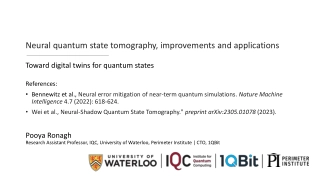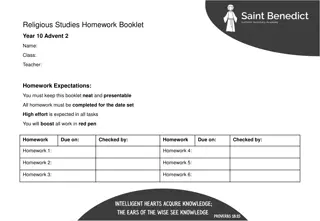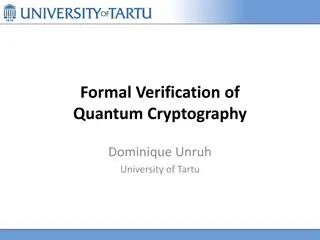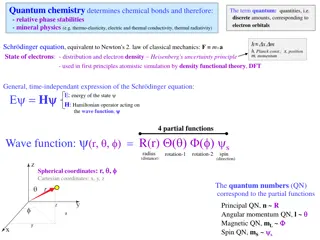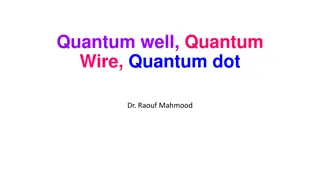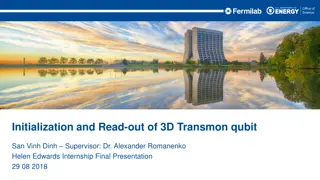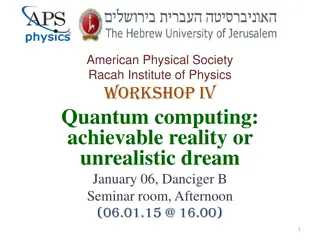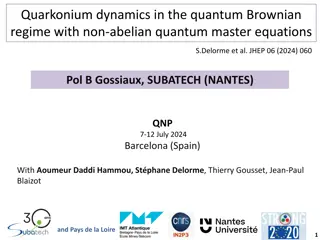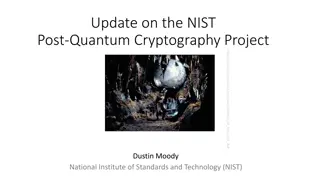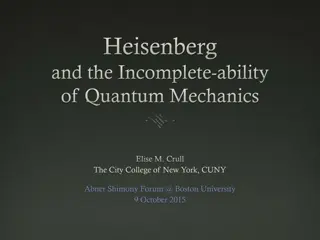QBism and Convivial Solipsism in Quantum Interpretations
QBism and Convivial Solipsism present different interpretations of quantum mechanics, focusing on the subjective nature of probabilities and experiences within the quantum formalism. QBism emphasizes the subjective interpretation of probability, considering the quantum state as a tool for assigning beliefs about future outcomes. In contrast, Convivial Solipsism views measurements as experiences that continuously shape an agent's interaction with their external world. Both aim to provide a correct understanding of the quantum formalism but with important differences in their approaches.
Download Presentation

Please find below an Image/Link to download the presentation.
The content on the website is provided AS IS for your information and personal use only. It may not be sold, licensed, or shared on other websites without obtaining consent from the author. Download presentation by click this link. If you encounter any issues during the download, it is possible that the publisher has removed the file from their server.
E N D
Presentation Transcript
QBismand Convivial Solipsism Herv ZWIRN Centre Borelli (ENS Paris Saclay) IHPST (CNRS, Paris 1) / LIED (CNRS, Paris 7)
Outline Presentation of QBism Main criticisms Presentation of Convivial Solipsism Common points Differences
Summary Both aim at giving a correct interpretation of the quantum formalism Solving the measurement problem Many common points But important differences
A bit of history The name QBism appeared in 2009 in a arXiv article which has been published in 2013. QBism is the current state of the version of Quantum Bayesianism that was initially developed by Caves, Fuchs, and Schack starting in 2002 but is no more accepted by Caves while Mermin adopted it more recently. Convivial Solipsism has been developed since 2000 following a remark of Bernard d Espagnat in his 1971 book Conceptual Foundations of Quantum Mechanics .
QBism The central subject of science is the primitive concept of experience which is the way in which the world impinges on any agent and how the agent impinges on the world QBists adopt the subjective interpretation of probability: probabilities represent the degrees of belief of an agent It is a single user theory . This means that: Probability assignments express the beliefs of the agent who makes them, and refer to that same agent s expectations for her subsequent experiences. (Fuchs, Mermin, and Schack, 2014)
QBism The entities of the formalism (wave functions, observables, Hamiltonians, probabilities) are not objective and attached to an external reality. They are subjective in nature and have no absolute value but are relative to a particular agent. They are not necessarily the same for all observers. QBists refuse the idea that the quantum state of a system is an objective property of that system. The quantum state is only a tool for assigning a subjective probability to the agent s future experience. It only represents the degree of belief of the agent about the possible outcomes of future measurements. So quantum mechanics does not directly say something about the externalworld .
QBism QBism does not consider quantum mechanics as a theory describing the external world, but as a theory that describes the agent s experience. A measurement (in the usual sense) is just a special case of what QBism calls experience, and that is any action taken by any agent on her external world. The result of the measurement is the experience the agent gets from her action on her personal world. In this sense, measurements are made continuously by every agent. A measurement does not reveal a pre-existing state of affairs but creates a result for the agent.
QBism The goal of quantum formalism is only to give recipes to allow agents to compute their personal degree of belief about what will happen if they do such and such experiment. QBists endorse a special kind of realism they call participatoryrealism where the agent and the external world interact in a creative way to give birth to an experience for the agent.
The Measurement Problem Conflictbetweentwopostulatesof evolution: The Schr dinger equation The reduction(or collapse) postulate
The Measurement Problem For QBists, unitary evolution concerns the change between the belief the agent has at time t0 for the outcomes of a measurement she could perform at t0 and the belief she has at time t1 about a measurement she would performat t1> t0. For QBists a measurement is the experience of an agent. There is no measurement when there is no agent. The collapse of the state is the updating of the agent s belief after she has got a result. Universality: For QBists, any agent can use the quantum formalism to model any system external to herself whether they be atoms, apparatuses, or even other agents.
EPR and Non-Locality Quantum correlations, by their very nature, refer only to time-like separated events: the acquisition of experiences by any single agent. Quantum mechanics, in the QBist interpretation, cannot assign correlations, spooky or otherwise, to space-like separated events, since they cannot be experienced by any single agent. Quantum mechanics is thus explicitly local in the QBist interpretation. Fuchs, Mermin, and Schack(2014)
Criticisms QBism leaves open some important questions whose answer would be necessary if one wants to get a precise detailed picture of what is going on. What is anagent? (QBistsdon t want to say) It is the interaction between an agent and the external world that creates a result. Without agent, there is no result. A macroscopic apparatus is not able to create a result. So, the agent is not an entity external to the formalism as in the classical theory of probability, but an internal entity. An agent must have experience. Does that mean that an agent must be conscious or that she must have perceptions? That is something that they are reluctant to accept.
Criticisms What is theontology? QBism endorses the existence of an external world independent of any agent, but it is not clear if the external world is unique and shared by all agents or if each agent has her own external world. The micro level of this external world is something unspeakable. There is no law ruling the behaviour of micro-objects. Something new really does come into the world when two bits of it [system and apparatus] are united (Fuchs,2006). How does this result appear from the interaction between a system at the micro-level which is unspeakable and without law, and a measuring device? New version: A result comes from the interaction between an agent and the external world. The result is only for the agent herself.
Criticisms Is the result in the agent s mind or is it in the external world, which would imply that each agent owns her personal external world? If it is only in the mind of the agent, then the result is non-physical, and it is not true that something new comes into the world . If the result is in the external world, how is it possible that the agent creates this result (which is not created simply by the interaction between the system andthe apparatus)?
The Convivial Solipsism Initial remarkfromBernard d Espagnat in ConceptualFoundationsof Quantum Mechanics (1971) and Veiled Reality (1994) ?0 ?? ?? ?? ?? ?? ?????= ?? ?0 ?0 ?? As in the Everett interpretation there is no reduction (the physical universe remains in a superposed state) but contrarily to what happens in the Everett interpretation, there is no multiplication of worlds and observers. There is only oneuniverse, oneworldandoneobserver.
The Convivial Solipsism How is it thenpossible to get oneunique result? The Theidea ideais is very verysimple simple Our brain does not allow us to perceive directly superposed states. When we look at asuperposedstate we perceive onlyonecomponentofthe superposition. The reason we do not experience superpositions is not because they do not exist, but because we are not capable of experiencing several different states simultaneously Lev Vaidman All is " Journal of Physics: Conference Series 701 (2016) There is noneed tohave manyworlds andmanyobservers.
We are not able of seeingsuperposed states and we perceive only one component
The Convivial Solipsism How Howis is it itthen thenpossible possibleto to get getone oneunique uniqueresult result? ? The Theidea ideais is very verysimple simple The universe and the observer remain physically in a superposed state but her / his awareness is hung-on to only one branch of the superposition which is chosen at random according to the Born rule. This solves the problem of probabilities that is pregnant in MWI. So a measurement is nothing else than the fact that when we look at a superposed state our brain selects one component of the superposition (written in the prefered basis) and our awareness hangs-on to this component. Nothing Nothing physical physical happens happens! !
The Convivial Solipsism Important points Important points Everything in the physical world remains entangled. In particular this is true also of the other observers who are, for one given observer, exactly similar to any other physical system. So an observer has to be treated by another observer exactly as a potential measurement apparatus when he does an observation. If Alice makes a measurement this is not a measurement for Bob. It is, for Bob, just an interaction between Alice, an apparatus and the system. An observer has no direct access to another observer s perceptions. When Bob asks Alice which result she got, Bob makes a measurement on Alice who stays, for Bob, in an entangled state until she has been measured.
The Convivial Solipsism Convivial Solipsim = ConSol Two Twoprinciples principles: : The hanging-on mechanism The relativity of states. There is no absolute state. States (and observables and hamiltonians, ) are relative to an observer (similarly to QBism and Relational interpretation).
The Convivial Solipsism A modified reality : for each observer there are two levels of reality (relative to the observer) The empirical reality All the potentialities that the observer could actualize. It is described by the global entangled wave function (which is often called the universal wave function in the Everett s interpretation) and evolves only through the Schr dinger equation. It remains entangled and no reduction happens. The phenomenal reality Eachobserver creates hisownphenomenalreality. All the results thatthe observer got through the measurements he did on his empirical reality. It is described by a tree of sub branches of the global entangledwavefunction. The The phenomenal phenomenalreality reality is iswhat what we but but we usually usuallycall the Reality call the Reality It It is is relative to relative to each eachobserver. There observer. There is is no no common commonand and shared sharedreality reality
The Convivial Solipsism EPR PARADOX AND NON-LOCALITY Allows to understand the EPR experiment and to avoid non-locality EPR correlations are not a real physical effect with an instantaneous action at a distance but are noticed by a first observer only when he meets the second observer or when he sees the results of the measurement of the second particle and this can happen only in a time-like interval No spooky action at a distance / No non-locality
The Convivial Solipsism IS THE PAST DETERMINED? It can happen that a past property A of a system S1 at T 1 is not yet determined at a posterior time T0> T 1, but becomes determined when the observer makes at T1> T0> T 1 a measurement of another property B (possibly on another system S2) whose result is linked to the value that A should have had at T 1to be coherentwith the result obtained on B at T1.
The Convivial Solipsism IS THE PAST DETERMINED? A and B two entangled particles: 1 1 ? ?+ ?? ?? ? = ? + ? ? 3 3 If Alice measures A first she has a probability 2/3 to find X and a probability 1/3 to find Y. ?? ??and when she will measure B she will necessarily find If she finds Y, she will be hung-on to the branch a. This is what happens in the EPR experiment. Finding a result for one particle fixes the result for the other. 1 ? ?and when she will measure B, she will ? + ? ? If she finds X, she will be hung-on to the branch 2 have an equal probability to find a or b. Knowing the result of the measurement on A does not determine the result of the measurement on B which remains undefined until a true measurement is made.
The Convivial Solipsism IS THE PAST DETERMINED? When the tree of branches constituting the phenomenal reality of the observer contains a superposition of values for A, A is not determined. Now A can refer to an event that is supposed to have happened in the past, for example A can be the value gotten by another observer during a measurement in the past. According to what has been said, the value remains undetermined until the observer from which the point of view is adopted makes a measurement of something that is compatible with only one value for A: For exemple asking the other observer what he saw or reading a result recorded with adate.
The Convivial Solipsism IS THE PAST DETERMINED? Example: On Monday at noon, the value of the spin along Oz of this particle that has been measured yesterday by Bob is undetermined for Alice who knows that the masurement has been done but has not communicated with Bob nor seen any report of the result, nor made any measurement correlated to this result. Alice s phenomenal reality is made of branches that contain a superposition of results for this measurement. At 1pm, Alice asks Bob about his result. That means that she makes a measurement on Bobwho is (forher) entangled withthe system. Throughthe hanging-onmechanismshe hangs-on to one of the two component of the superposition and becomes aware of a defined value, let s say +. Then at 1pm it becomes true for Alice that the spin along Oz of the particle hasbeen +since yesterday, while atnoonit was still undefined.
The Convivial Solipsism IS THE PAST DETERMINED? The past of each observer contains many properties that are undetermined until the observer makes a measurement that is compatible with only one value of them. It is at the time ofthis measurementthat the value ofthe pastproperty becomesdetermined.
QBismand Convivial Solipsism Common Points: Quantum mechanics is about the interaction of an agent or an observer and an external world knowable at best very partially and imperfectly Quantum states are relative to the observer Quantum states are not directly describing the physical state of the system The measurement is linked to the observer (no observer -> no measurement) The collapse is not a physical eventon the system The quantum formalism is universal (it can model other agents or observers) The Reality is relative to each observer (perspectival point of view)
QBismand Convivial Solipsism Differences: Whatisclearin ConSol and not in QBism What a measurement is and whythe observer gets one result The roleof the observer s perception The status of the Reality InQBism theresult is really createdin theexternal world (How?) InConSol the result isonly in theobserver s perception.
QBismand Convivial Solipsism Thanks! QUESTIONS


